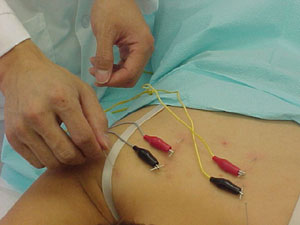| Consider This Therapy For |
| Acupuncture is promoted as a treatment for pain--and there
is absolutely no question that it does in fact provide
short-term benefit for many of the people who try it. By some
estimates, between 50 and 70 percent of patients with chronic
pain receive at least temporary relief when treated with
acupuncture, and some experience long-term relief as well.
|
|
|
How the
Treatments Are Done |
 |
The "puncture" in acupuncture refers to
insertion of tiny needles at certain very specific points on
the surface of the body. The treatments vary widely, depending
on the individual practitioner and the style of acupuncture.
There are several "schools," including Chinese, Korean,
Japanese, and a westernized version (based on neurology, not
Oriental medical philosophy) called trigger-point therapy.
Most practitioners of Oriental-style acupuncture perform at
least a partial physical examination at the first visit
(including extensive pulse-taking and, possibly, examination
of the tongue and palpation of the abdomen). They also tend to
take a very detailed medical history, including nutritional
habits and other environmental factors.
The actual insertion of the hair-thin, disposable needles
has been described as feeling like a mosquito bite. After
insertion, the needles may be stimulated by twirling them or
connecting them to a mild electrical current (there is no risk
of electrical shock). This stimulation may cause a mild
tingling or aching sensation referred to as "de qi." The
needles may be inserted from a fraction of an inch up to about
one inch deep. They can either be withdrawn a few seconds
after insertion or kept in place for up to 30 minutes.
Treatment Time: Typically, you should allow 20
minutes to 1 hour per session. The initial visit may take
longer. |
| Treatment
Frequency: This varies according to the problem. You may
start out with several treatments per week, then taper to
weekly or less often. Duration of therapy may range from a few
treatments for acute, temporary problems to regularly
scheduled treatments over several months for chronic
conditions. |
|
|
What
Treatment Hopes to Accomplish |
| Acupuncture has been practiced in China for
several thousand years, although this traditional healing art
didn't catch Americans' interest until the early 1970s, when a
Western reporter in Beijing received acupuncture for
postoperative pain (after undergoing an appendectomy under
conventional general anesthesia).
How acupuncture works remains a mystery. According to
ancient Chinese medical theory, the life force (called qi
or ch'i and pronounced "chee") flows through the body
via 14 invisible channels (called meridians), regulating all
physical and mental processes. Opposing forces within the
body, called yin and yang, must be balanced to keep ch'i
flowing properly. The meridians
|

Electric Acupuncture
|
| supposedly run deep within the
body's tissues and organs, surfacing at some 360 places
identified as acupuncture points, sometimes called acupoints.
Certain meridians are identified with organs such as the
bladder or liver, and the points all along such
meridians--even in the hands or feet--are believed capable of
affecting the associated internal organ. Stimulating these
points is said to balance and restore the flow of ch'i. An explanation proposed by Western
scientists is that acupuncture may trigger the release of
natural pain-killing substances within the body called
endorphins, thus blunting the perception of pain. It may also
alter the body's output of neurotransmitters such as serotonin
and norepinephrine, and of inflammation-causing substances
such as prostaglandins. Like the manipulation of ch'i,
however, this explanation has yet to be conclusively
documented.
Whatever the cause may be, the pain-relieving effects of
acupuncture seem to have a delayed onset; they increase
slowly, even after removal of the needles, and may become more
evident after several treatments. The effects may diminish
after acupuncture treatments are ended.
|
|
| What Side Effects May Occur? |
| Acupuncture has no inherent side effects. However,
careless application of the technique can present certain
hazards. There have been documented cases of hepatitis B
transmission and serious bacterial infection due to improperly
sterilized needles, a problem that has been controlled by the
widespread use of disposable needles. Improperly performed
acupuncture can also cause bleeding (if a blood vessel is
punctured) or injury to organs, nerves, or tissue, making it
important to find a skilled and reputable practitioner. |
|
| Who Should Avoid This Therapy? |
| In general, there are no medical conditions that rule out
the use of acupuncture except, perhaps, a morbid fear of
needles. People at risk of easy bruising or excessive bleeding
(for example, patients with clotting disorders and those
taking a blood-thinning medication) would be prudent to avoid
acupuncture, since there is a slight risk of damage to blood
vessels. Pregnant women should avoid needle insertion on or
near the abdomen. |
|
|
| |
|